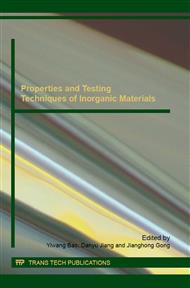p.3
p.9
p.13
p.17
p.21
p.25
p.30
p.35
Evaluating High Temperature Modulus and Strength of Alumina Tube in Vacuum by a Modified Split Ring Method
Abstract:
Alumina is a typical ceramic material and possesses high strengthand stiffness at both room temperature and high temperature. The split ring methodhad been established to evaluate the elastic modulus and bending strength of aluminatube materials at ambient temperature. However, both equations for modulus andstrength became lightly inapplicable with the increased temperature. For theelastic modulus, it was lack of precise approaches and advices for deformationmeasurement in the heating furnace. For the bending strength, changes of sampledimensions due to thermal expansion would take an effect on the calculatingresults. In this work, several improvements have been taken into account tocalibrate the above deviations. Results revealed that the modulus and strengthregularly decreased from room temperature to 1300 °C and accorded well with other conventional testing methods.It proved the accuracy and reliability of this modified split ring method,which might be used to evaluate other ceramic tube materials at hightemperature.
Info:
Periodical:
Pages:
9-12
Citation:
Online since:
February 2016
Authors:
Price:
Сopyright:
© 2016 Trans Tech Publications Ltd. All Rights Reserved
Share:
Citation:


